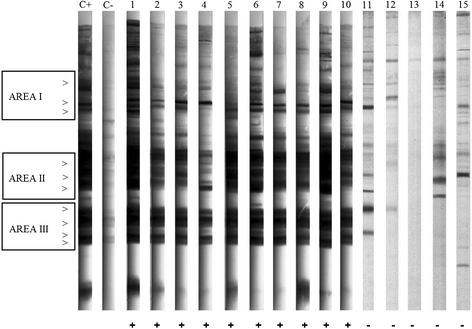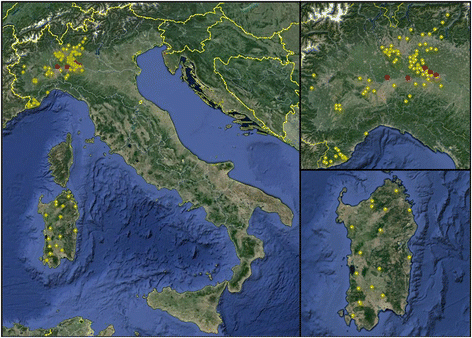Besnoitia besnoiti among cattle in insular and northwestern Italy: endemic infection or isolated outbreaks?
- PMID: 25491281
- PMCID: PMC4271444
- DOI: 10.1186/s13071-014-0585-4
Besnoitia besnoiti among cattle in insular and northwestern Italy: endemic infection or isolated outbreaks?
Abstract
Background: Bovine besnoitiosis, caused by the apicomplexan Besnoitia besnoiti, is a chronic and debilitating disease considered as emerging in Europe. In Spain, Portugal and France it is endemic and foci of infection were recorded in Germany, Switzerland, Hungary, Greece and Italy. In Italy, cases of bovine besnoitiosis were registered both in imported and autochthonous cattle, and mostly in central regions; high seroprevalence was also revealed by an epidemiological survey performed in the southern part of the country. Aiming to update information on the disease in northwestern and insular areas of Italy, where data on bovine besnoitiosis were missing, a serosurvey was designed for the present study.
Methods: Three thousand one hundred and forty bovine blood samples from both dairy and beef farms (n = 126) were collected in northwestern regions (Lombardy, Piedmont and Liguria) and in the island of Sardinia. Samples were analyzed by a standardized in-house ELISA and those resulted positive were re-tested by Western Blot (WB) for confirmation. On results obtained by both ELISA and WB, apparent (AP) and true prevalence (TP) were calculated at individual and herd levels. Further, a panel of sera resulted positive to ELISA was analyzed by IFAT.
Results: A total of 712 animals (AP = 22.7%; TP = 18.8%) and 109 farms (AP = 86.5%; TP = 88.2%) showed a positive reaction in ELISA. Only ten (AP = 0.3%; TP = 0%) specimens proceeding from five farms (AP = 3.9%; TP = 1.7%) from Lombardy were confirmed positive to the WB, corresponding to two Holstein Friesian cows and eight beef cattle. IFAT showed a low sensitivity (44.4%) scoring positive in only four samples out of 9 positive to WB.
Conclusions: The survey demonstrated that bovine besnoitiosis cannot still be considered endemic in whole Italy. In fact, independent foci of infection were registered only in Lombardy region. Therefore, a sanitary strategy aimed to increase control measures and to organize monitoring plans, by adequate diagnostic tools is necessary to avoid overestimation of B. besnoiti in Italy.
Figures



References
-
- Lienard E, Salem A, Jacquiet P, Grisez C, Prevot F, Blanchard B, Bouhsira E, Franc M. Development of a protocol testing the ability of Stomoxys calcitrans (Linnaeus, 1758) (Diptera: Muscidae) to transmit Besnoitia besnoiti (Henry, 1913) (Apicomplexa: Sarcocystidae) Parasitol Res. 2013;112:479–486. doi: 10.1007/s00436-012-3157-6. - DOI - PMC - PubMed

